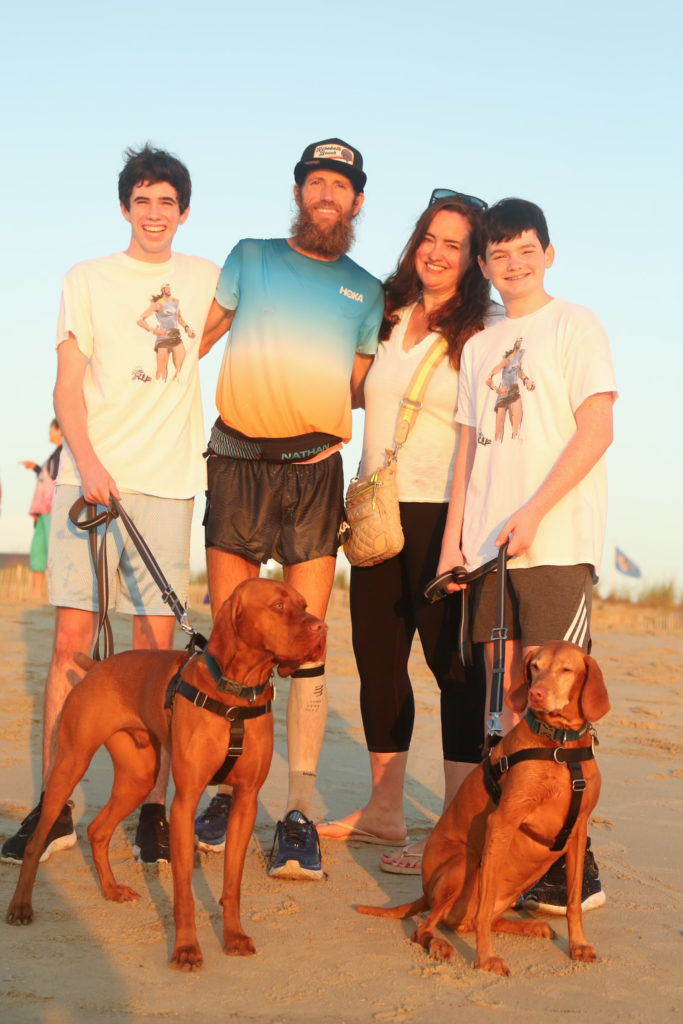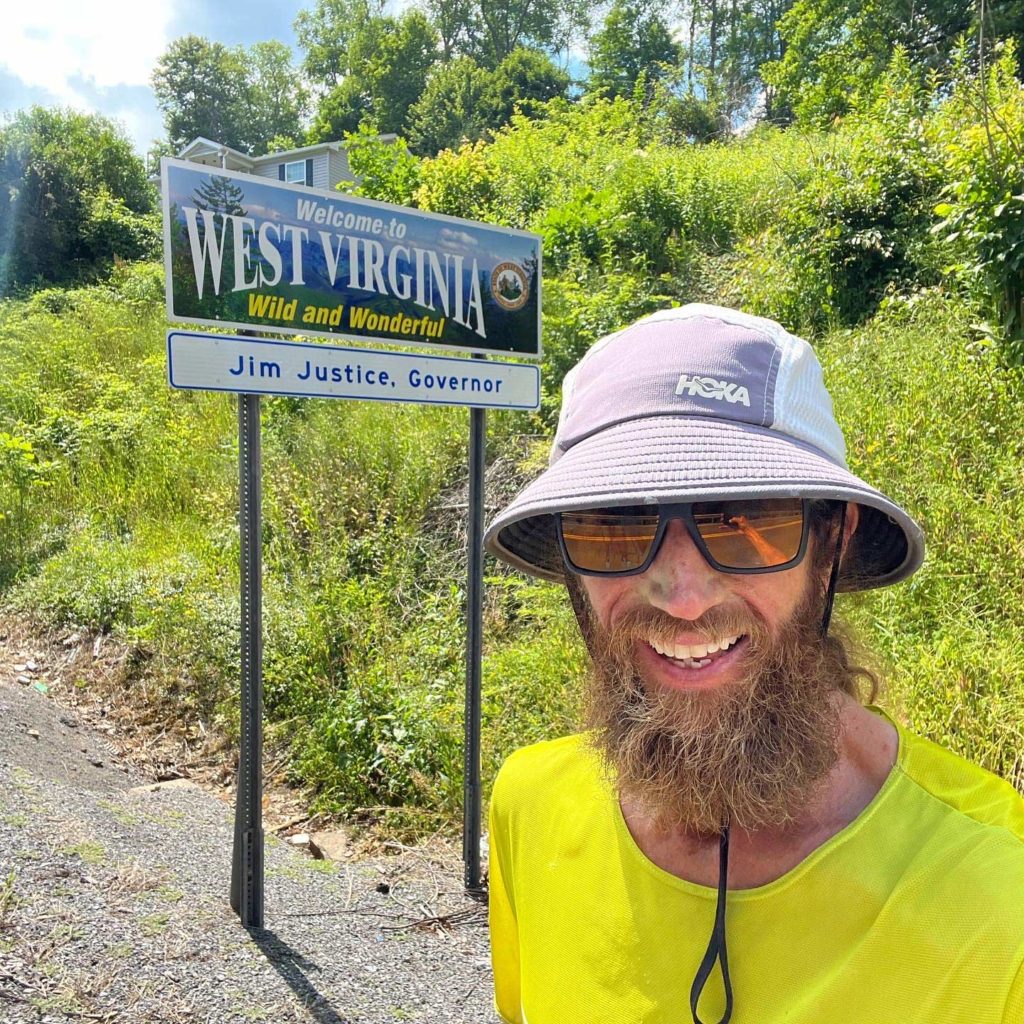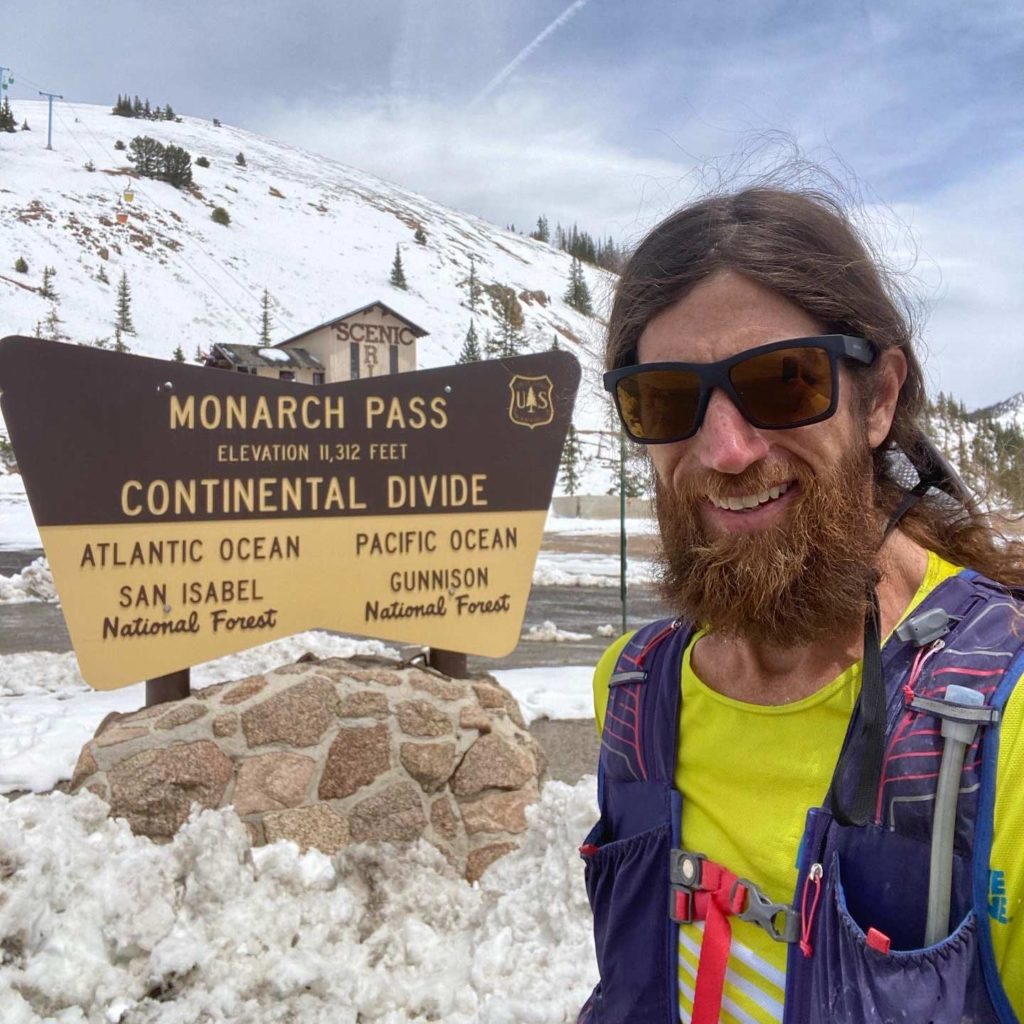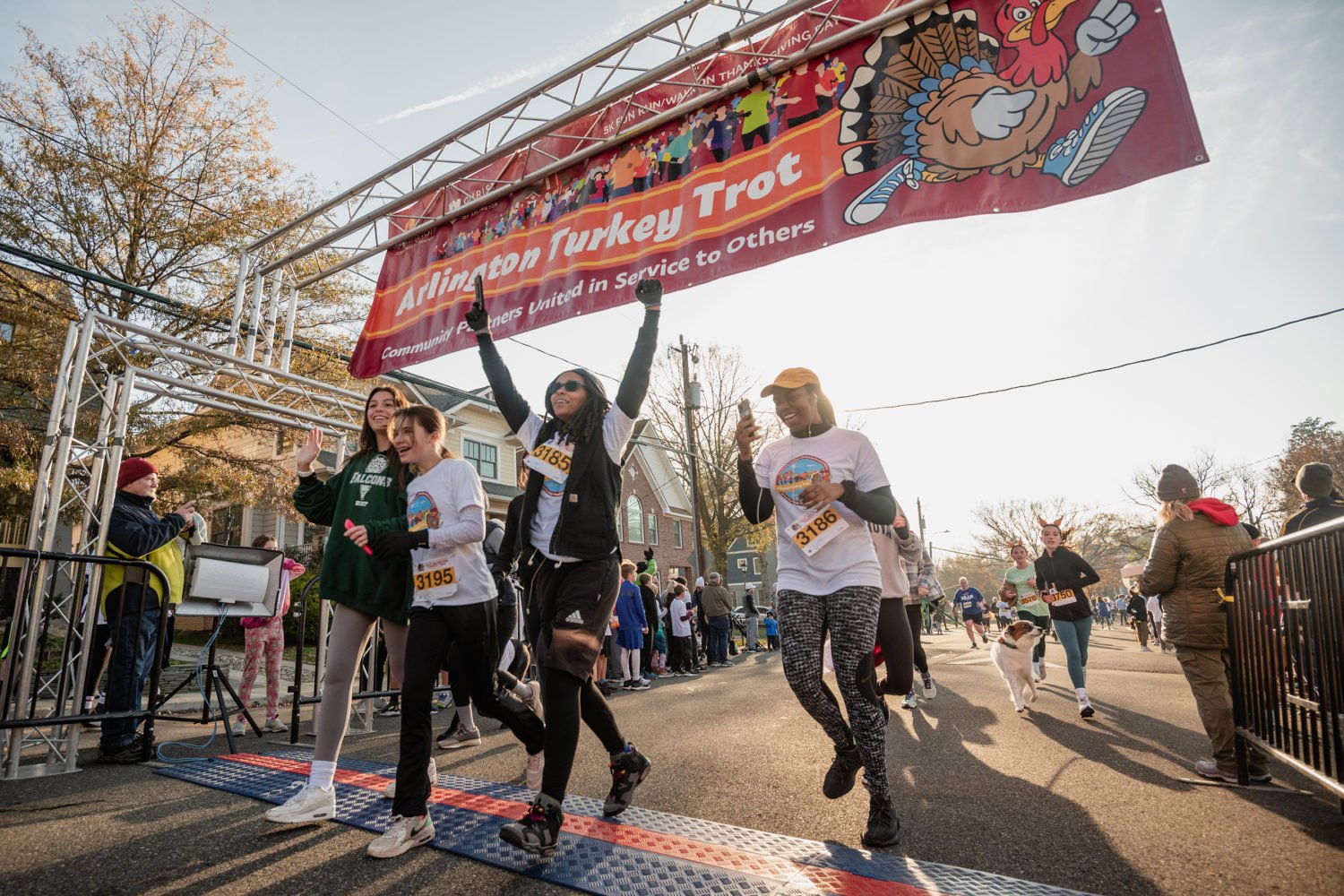Approximately ten minutes after we meet and only five minutes after we secure a table upstairs at Arlington’s Northside Social, Michael Wardian, with my encouragement, props his left ankle up on his right knee and gently slips off a canvas shoe to reveal the most disgusting foot I’ve ever seen.
Scabby and blistered and peeling like a sunburn, the arch of his size-11 foot looks as if it’s been gnawed on by a small critter, like corn on the cob. I feel as though this wounded appendage ought to be swaddled in gauze, but it’s bare inside his shoe, and Wardian’s walk seems unaffected. He started the morning at 5:30 playing pickleball for hours and would end the day driving to a Dead & Company concert at Jiffy Lube Live. At this stop in between, he’s sipping a cold lemonade (he doesn’t do caffeine or alcohol) and nodding with approval as I explain I’ll be taping our interview on two devices, my phone and a recorder. “Two is one, and one is none,” he says. “I think that’s a SEAL thing.”
The ravaged state of his foot is not for lack of care, because as Wardian ran 3,234 miles across 13 states—from the front steps of San Francisco’s city hall to the shores of Rehoboth Beach, including a slight backtrack at the start so he could begin with his toes in the Pacific and end with a dip in the Atlantic—he began each morning not by loosening his limbs (he did zero stretching) or carbo-loading on some delicious, indulgent breakfast (he “forced” himself to eat every hour on the hour and found no pleasure in it: “It was just annoying to eat and chew”) but by devoting a full 20 minutes to taping his feet. The foot-taping is an art-form-slash-science he has spent years mastering “so that every footfall isn’t excruciatingly painful,” he says, before clarifying: “Which it was, but not on my entire foot.” The best taping job in the world will go to pieces if you haven’t put your socks on properly, another task Wardian has dedicated a not-insignificant amount of time to conquering. (The key is to pull them up slowly, without haste, “because if you rush putting your socks on, it’ll roll the tape up and then it’ll cause more blisters.”) Lest you think the damage came from inadequate footwear, know that Wardian, who counts Hoka as a sponsor, made very careful considerations about what sneakers to wear and how often to change them: He rotated mostly between Hoka’s Mach and Bondi models, with the Rincon in the mix every now and then, and swapped pairs every 20 to 30 miles.

There’s just no way to run some 50 miles a day (i.e., two marathons, give or take) with more than 132,000 feet of changes in elevation in just 61 days (starting May 1 of this year and ending July 1) without the effort taking a real toll on your soles—even if, like Wardian, you’re a professional ultramarathoner with 25 years of experience whose previous feats of extreme cardiovascular fitness include but are not limited to: running 631 miles across Israel in ten days, setting a fastest known time for the feat; knocking out ten marathons in just under three days by doing loop-de-loops of your block in Arlington Forest; and running seven marathons on seven continents in seven days (actually, he’s done that twice, and the first time, he set a world record, completing the full challenge faster than any runner before him). Though many a Washington resident has been locked in interminable traffic and fumed, “I could probably walk home faster than this,” Wardian is the kind of person who will follow through on this line of thinking by running 90 miles around the Beltway on what turns out to be the hottest day of 2019 (a high of 96 degrees) in 17 hours, 54 minutes, and 59 seconds.
Even as a child, Wardian had an obsessive nature. The day his parents got him an Atari, he played Pac-Man for 18 hours straight until he beat the whole thing and had a blister on his thumb.
“Mike is definitely revered. He’s one of the most accomplished people in the ultra space,” says Robbie Balenger, who completed his transcontinental run in 2019. Balenger remembers being “shocked” by Wardian’s marathon personal records, given the athlete’s prowess at super-long-distance runs. “To find that diversity is very rare: someone who can just fly in a marathon and can run across the United States.” Balenger joined Wardian for 15 miles of his leg through Colorado, on a morning when it was, in Balenger’s words, “completely shitting snow.” Wardian’s standard start time was 6 am. Balenger figured: There’s no way he’s starting at 6 am. “And we got there at 6:05 and he was already running.”
“He was just so in it,” Balenger says. “And it didn’t even really seem to be much of a struggle.” Since meeting Wardian that day in Colorado, “I’ve been referring to him as the wizard.”
Wardian is polite and warm, though only sometimes effusive, and describes his objectively impressive feats with neither faux humility nor macho bravado but in the matter-of-fact way you might recount a long but productive day at the office. His low ponytail and short beard are the same red-brown as the coats of his two vizslas, Rosie and Sebastian (“Bash”), and he has the well-lined skin of a 48-year-old man who has spent most of his waking hours outdoors and most of his hours awake. He says he needs only four hours of sleep a night and that one of his not-so-secret secrets to managing an intense running schedule with a full-time job (he’s a partner of an international shipping company) and family commitments (to his wife, Jennifer, and their sons, 13-year-old Grant and 16-year-old Pierce, whose middle name, in a nod to Wardian’s passion, is Miler) is to wake up at 4 in the morning to get his runs in before the day really dawns. And Wardian has found creative ways to weave these threads of his life together. In 2007, he set a world record for running a marathon while pushing a baby in a stroller: With ten-month-old Pierce in tow, Wardian completed the Frederick marathon in two hours, 42 minutes, and 21 seconds.
Even as a child growing up in Oakton, Wardian had an obsessive, competitive nature. The day his parents got him an Atari, he played Pac-Man for 18 hours straight until he beat the whole thing and had a blister on his thumb. He got into lacrosse and wanted to practice every day, so his dad built him a goal out of wood and Wardian “would break the corners off of it.” He played lacrosse at Michigan State, ran his first marathon, the Marine Corps, in 1996 and his first ultramarathon the following year. (An ultramarathon is any race longer than a marathon. Technically, a 26.3-miler would count, though Wardian’s first was the JFK 50 Miler, which he has since run ten times, winning in 2007.) He knows a lot of runners who started competitively much earlier than he did, and he’s grateful he took his time finding this path. “I think maybe it was a blessing that I didn’t run at that point, because I still have a love for it. I think a lot of kids, when they’re running growing up, [can] do too much too fast, or they just burn out. I know I haven’t gotten that yet, and I hope that I never do.”

Wardian met Jennifer in the spring of 1996, when she was attending Washington College in Chestertown, Maryland, with his brother. “[Michael] was just a normal 20-year-old,” Jennifer tells me. “He would drink and party. But he would also then get up and run 40 miles on a Sunday morning when the rest of the college town was still asleep.” Before they started dating, Jennifer remembers sitting around with friends recapping the night and wondering, Where is Matt’s brother? “And someone would say, ‘I just saw him running in the next town over.’ ”
Two years later, when they were a couple, Wardian’s running “was something I tolerated,” Jennifer says. “He’s not somebody that’s going to compromise on stuff like that. So I knew what I was getting into, for sure. It was just like, Ugh, all right. Not a check in the positive column of the pros and cons of dating him. It was always a con.”
Wardian knew even then that his goal was to become a professional runner. He was a natural at long distances, an easy early riser. “I love moving through the world under my own power in that way,” he says. “I like the sense of adventure you get every time you go out for a run.” And he wanted to avoid a fate he’d seen befall so many others: “A lot of people get locked in a corporate life.” But with running, he and Jennifer have “seen what it would look like with a different outlook on life,” one in which his office job doesn’t dominate his days (or suck out his soul).
Early in their relationship, Wardian did the Marathon des Sables, a six-day, 250-kilometer race in the Sahara. “I really thought I’d never see him again,” Jennifer says. “I thought, ‘That’s insane.’ ” Since then, Wardian has completed that race, for which runners carry food, gear, and a snakebite kit while knocking out anywhere from 20 to 50 miles a day, two more times. In 2010, he placed third with the best-ever time by an American, in 23 hours, one minute, and three seconds.
As Jennifer tells it, Wardian’s running has empowered the couple to travel the world and form genuine friendships and—since he’s started earning real money from sponsors—enabled Jennifer to be a stay-at-home mom. His running career “does not consume our lives probably the way people assume it does,” she says. “One of the keys to his success is that it’s just one of the things he does. Maybe he appreciates it more when he’s doing it, because he knows he’ll be sitting at his computer for a few hours the next day.”
Despite all the time he spends running, she says he’s “a great and engaged father and partner.” Although their kids, she adds, “are very unimpressed by almost everything he does, and I mean that in a great way.”
Running Count
61
Days it took Michael Wardian to complete his run across the United States
3,234
Miles he ran, from San Francisco to Rehoboth Beach
13
Number of states he passed through
11,312
Elevation, in feet, at Colorado’s Monarch Pass, the highest point of Wardian’s transcon
6
Hours he spent running past a single ranch—Walker Ranch in Colorado
0
Number of times Wardian stretched during his run
3
Pairs of shoes he had to retire
24
Approximate hours that Wardian ran, straight, in the final stretch
104
Miles run in that final 24-hour stretch
In 2020, Wardian competed in the Spartan Games, in which elite athletes race through obstacle courses, swim in open water, and throw boulders and such to determine who is the fittest of them all. “I got smoked, which was fine,” Wardian says, except for the part where he herniated the L5-S1 disk in his back, which, in addition to being very painful, carried a more existential threat: Would he ever be able to run again?
“That’s when I decided: I want to try to do this run across the country,” Wardian says. He’d been talking about it forever, but all the details seemed overwhelming—how to pay for it, how to get time off, how to make sure his family was okay while he was away. But he was determined to make it happen if he got healthy again.
Despite the costs and risks, there’s something undeniably tantalizing about the idea of running across America, even for runners who have done everything else. The first person to do it was Edward Payson Weston in 1909. Since then, only 300 or so people have followed. Compare that with the thousands who have summited Everest.
Wardian was able to avoid surgery, working instead with specialists from MedStar (another sponsor) to get cortisone shots and a few months of physical therapy. He hired someone to help out at the shipping office and someone else to help him map out the route. (“He has a bad track record for getting lost,” Jennifer tells me. “A couple years ago, he called me from the Gobi desert. He was like, ‘Do you think you could—’ I’m like, ‘Don’t even finish that sentence! Why are you calling me? Call the race director!’ ”) Making matters more complicated: The United States, you may have noticed, is not designed for travel by foot. “It is very dangerous,” says Balenger. “Statistically, your chances of getting hit by a car when you take on a transcon go up exponentially.”

Despite the costs and risks, there’s something undeniably tantalizing about the idea of running across America, even for runners who have done everything else. The first person to do it was Edward Payson Weston in 1909. Since then, only 300 or so people have followed. Compare that, Balenger says, with the thousands who have summited Everest and you can get a sense of, as he puts it, “this rarity of feat—the transcon is really where you can legitimize yourself.” (Counterpoint, via Jennifer: “I think anybody could do it if they tried. When we first told people, they were like, ‘What!?’ And I’m like, ‘He’s not special! Hundreds of people have done it!’ ”)
Wardian comes down somewhere in the middle. “I think most people can do a lot more than they think they can,” including run incredible distances, he says. “What’s awesome about running is it doesn’t really care. It doesn’t care what your background is. It doesn’t care who your parents are. It doesn’t care how much money you have. It doesn’t care how much you think you’re good. It doesn’t care if you are genetically gifted or not. If you’re willing to put the time and effort in and work at it, you’ll get better.”

On his transcon, Wardian got a view of America that most of us never do. He was shocked at the vastness and the beauty, the miles of feedlots, the hilliness of supposedly flat Kansas. He was taken aback by the entitlement that those in cars and trucks feel to every square inch of road. He passed the hours on the phone with his family and by listening to podcasts and more than 35 audiobooks, including “trashy” young-adult vampire fiction such as the Crave series. He found that “emotions get very raw” when long-haul fatigue kicks in. (He cried over the death of a character in Covet, the third Crave book.) The exhaustion of the run, he says, “strips away all the pretense of who you thought you were and who you told everyone you were.”

Sometimes he was floored by the generosity of strangers who kept up with his route via Wardian’s social media: the person who made a 13-hour trek just to deliver him a pumpkin pie, the woman who drove 90 minutes with her vizsla so Wardian, homesick for Rosie and Bash, could pet her dog. Other times, he was stunned by their malice and careless cruelty: the random person who threw a half-eaten hamburger at him, the guys in diesel trucks who’d slow down to blow black smoke all over him (“coal-rolling,” for the uninitiated), and the time a truck driver drove him off the road, making him pop his hamstring and potentially ending his run before he made it to the finish. For the rest of the day, he was unable to run or even lift his right leg—he walked ten miles in 98 degree heat: “It was miserable.” But the following morning, he felt “not terrible.” He iced his leg and started the day walking until he thought he could run again, which he could. (“I felt elated.”)
“Mike took it so personally every single time” someone harassed him on the run, Jennifer says. “For him, it felt like a very personal assault. He doesn’t curse—he’s an even-keeled guy. And he was screaming. It was day fiftysomething, and I thought, ‘He’s losing his mind.’ ” Just then, a woman pulled up and offered Wardian a ride. He explained, “No, I’m good, I’m running across the country.” She circled back to offer again, promising, “I won’t tell anybody!”
“And he burst out laughing,” Jennifer says. “I think those heartwarming moments all came at exactly the right time.”
Wardian swears that the positive encounters outnumbered the negative ones ten to one: “There wasn’t a single day during that entire run where I woke up and was like, ‘I don’t want to do this.’ ”
Aside from appreciating his altruistic bent—his run raised more than $100,000 for World Vision, which provides clean, safe drinking water to children and families around the globe—how many people, I ask Wardian, find out about his whole deal and say, ‘Oh, you’re a fully crazy person’?
“A lot of people say that, actually,” he says. “But I feel like it’s just because it’s something that’s so foreign to them.”
He offers another example: “I don’t know about you, but I could be inspired by someone if they’re into snails.” Snails? “If they’re super into it, it’s cool to me.” Wardian used to collect comic books—he knows from fixations that sometimes make people go, hmm. But he sees something powerful in the act of caring deeply about almost anything, maybe especially the things some people might dismiss as a waste of time and energy, “if it really gives that person joy—and I think people see that in me when they see me do these things.”
Wardian has no plans to retire, though he does have ideas about diversifying his athletic-achievement portfolio: “I want to row the Atlantic. I want to go to the top of Everest and some of the other big mountains. I still want to have a lot of adventures, and I know running will be at the forefront of that for sure. . . . I think running gives you a base to be able to do anything.” It’s not that running is easy, particularly at this level, but that he gets something from it that he doesn’t get anywhere else. “And so I think I’ll always run as long as I can.”
It depends, Wardian says, on when he’s running, and where, and if he gets to be on the shady side of the street. But when he’s really in it, “most of the time, it’s great,” he says. “It feels like freedom to me.”
This article appears in the September 2022 issue of Washingtonian.








